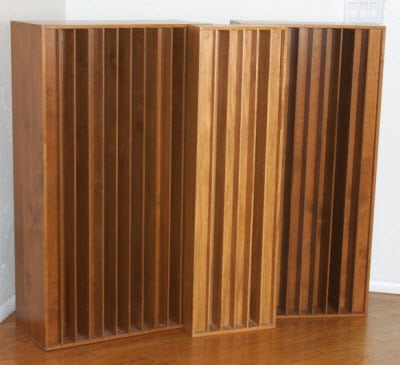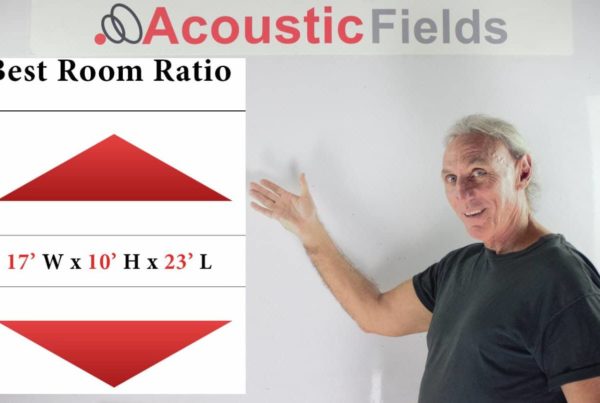A good question I was sent this week asked “Do diffusers make a difference to room sound pressure? Can I create a good room frequency response with diffusers?” Well here we’re confusing terms a bit. Remember in rooms there is pressure management and reflection management. Pressure management is below 100 cycles, a diffuser does not work below a hundred cycles. So there’s no way a diffuser could have anything to do with pressure management.
So a diffuser is a reflection management instrument as far as I’m concerned. It’s way more than a tool. It’s an instrument because it actually creates a little bit of sound on its own.
If you ever hear a car horn in the distance then that is a diffused sound. It’s traveling through the air and it has plenty of time to spread out and that’s what a diffuser does. Only the diffuser does what you hear with the car horn and does it in a small space. The car horn outside the window has a lot the air and a lot of space and a lot of distance to spread out before it reaches our microphones and ears but in a small room we don’t have that luxury of space. We don’t have that luxury of volume. We don’t have the luxury of the air for the sound to move through so we have to, not cheat as such, but we have to help the laws of physics out. So that’s what a diffuser does.
A diffuser packs a of lot energy
A diffuser packs a of lot energy in terms of its ability to distribute sound into the room, into a small package. So we can get that big car horn sound that you would hear from maybe a hundred or 200 meters away. You can get that large sound in a small room with a diffuser. So diffusers are reflection management tools.
Sound absorbers are pressure management tools. So those are the two languages that we always need to keep in mind with small rooms. Now back to the original question “Can I create a good room frequency response with diffusers?”
As a general rule you want to use the diffusion sequence that’s the largest that you can use within the physical space that you have. Now that said you also have to keep in mind the distance from the diffuser to the listening position and the diffuser to the monitoring position.
Whatever that distance is, that has to be calculated to what diffuser you should put in that location. So there are two things to consider:
1. Try to get as much diffusion as you can in the space you have to work with but
2. Also be cognizant of the fact that whatever diffusion sequence you put in that space, you leave enough distance for our car horn example for the sound to travel and spread and be diffused at the listening position.
With the car horn example we had a hundred meters, in a room we might have 5/10 feet, two meters, three meters. So we’re going from a hundred meters with the car horn to two or three meters in a small room. Well how do we get the same sound? Well we’ve got to use physics. We’ve got to take the energy and spread it out so it sounds like the car horn a hundred meters away and that’s where the diffuser comes in.
So use the largest and widest diffusion sequence, diffuse the most frequencies that you can within the space requirements that you have but also keep in mind ‘Am I sitting far enough away from the diffuser to give it time to do its job, to give it time for the wave form that strikes the diffuser to spread out and become diffused?’
That takes time which is our constant and it also takes distance. So that that’s how we have to look at, keeping in mind the greater the prime number, the deeper the diffuser. A prime 7 diffuser is 4 and a quarter inches deep, a prime 43 is 41 inches deep, more than a meter and I’ve built a few of those. They’re 85 inches wide and a meter and a half deep. They have 42 wells in the sequence, so they’re wonderful and they go down to 90 cycles, a hundred cycles but who’s got a meter and a half of space to give up? That’s a lot of space but it’s a great diffuser but then you need the appropriate distance for the wave form so our lowest frequency from our past videos let’s call it a hundred cycles.
So you’re going to need a hundred cycles, you’re going to need 11-feet, roughly 11-feet for the wave form to be fully formed, a hundred feet at a hundred cycles. So you need large distances. If in doubt send me your distances and I’ll tell you what series works best and I might even advise you to try to knock out those walls and make the room bigger. No, I’m just kidding.
Think of it like sitting too close to a big screen TV
In terms of an analogy think about how, with a big screen TV, you don’t sit with your nose pressed up against it to watch TV. You’ve got to have that space in order to take in the full picture. The reason for that is, is that our eye is about a fifty millimeter focal length. So the way our eye is designed is about 50 millimeters and 50 millimeters requires a certain amount of distance between what it is looking at and the camera which is your eye.
So when you point a camera at an object and you adjust the focus you’re changing the focal length. When you look at something your eye does whatever it does to make those distance adjustments. Well it’s the same thing with sound. So we’re dealing with light for vision and we’re dealing with sound for audio.
So everything has to travel through air, everything has a speed, everything has limits how fast it can go. It stays the same speed most of the time, depending on the medium of transmission, so that’s good. Thank God it’s constant, there are too many other variables going on that we don’t need the speed changing on us as we’re trying to figure stuff out. So yeah that’s why you have to sit back from a TV. They have formulas for it but a 2-meter widescreen I think you have to be back 15-feet or so.
Is there a room dimension formula for layman’s to consider in getting a good room frequency response?
Well there is and we’ll do a video on that but the best thing to do in this situation is send me your footprint, send me what you have to work with and I’ll plug it into our database and that’ll tell us more than trying to guess good ratios. So if we know the space you have to work with, the maximum footprint, I mean ‘Dennis this is the most space I can give you. What can we do within this space?’ then I’ll plug it into our database and then we can see exactly what the pressure and reflection issues are for that room size and volume and since you gave me the maximum I know that I can even go a little smaller to get you better sound and that that’s what we do.
In a lot of cases we actually make the room smaller to get better sound. Now we can only make it smaller to a certain point so we don’t have large margins to work with but we do have some and that’s why it’s just so much better to plug it into our database which is a 116 rooms built and measured. Your room size will be in there. That way I can tell you “Oh if we went another foot we’d be great, if we reduced it another foot we’d be good, if we lower this or extended this we’d be good we just have some reference points to work with”.
We will do a video on some general guidelines to use, there’s ratios of height, width and length I think that are more important to discuss, the ratios than actual dimensions cause you get a feel for the ratios of height, width and length. I think it’ll be easier for you to apply that to some possible areas that you have fought for your room.
In Summary
If you would like your room acoustic issues analysed for free by me then please fill in the form here and I will be happy to take a look for you.
Thanks
Dennis









Our 52″ TV is located 14′ from our ears where we sit. Wife and I can’t understand it. The TV speakers are broken so we have two external speakers (Stereo). We can’t understand a spoken word! We must use wireless headphones which are bad news if we have company. A friend installed a center speaker for us but it makes the audio clear at only 5-6″ from the TV. [Do speakers have “focal lengths”?] Is this an application for a defuser? This self designed house is an acoustical open floor nightmare. I don’t know how you get time to answer questions from a whole nation of people, but if you can, thank you so very much.
L, I will need to know much more about your room. Fill out the information in this link. Include photos of all room surfaces. https://www.acousticfields.com/free-room-analysis/